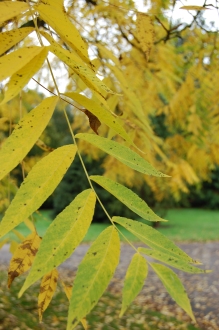Position: Full sun
Flowering period: Late spring
Soil: Moist, well drained
Eventual Height: 30m
Eventual Spread: 20m
Hardiness: 4b, 5a, 5b, 6a, 6b, 7a, 7b, 8a, 8b, 9a, 9b
Family: Juglandaceae
Juglans nigra is a long lived, deciduous tree with a broad crown. Its dark green, waxy leaves are alternate, odd-pinnate with up to 23 leaflets with entire margins and up to 60cm long. Its leaves turn yellow in autumn before they fall. Its twigs contain air spaces and appear hollow when snapped. Its trunk may achieve a diameter of 2m. Its bark is grey/ black and deeply furrowed. Its flowers are monoecious. Its green male flowers being drooping catkins which are up to 10cm long and appear in clusters of up to 5. Its green female flowers are small and insignificant, are terminal and appear in groups of up to five. Its fruit are green/ brown, up to 6cm across when ripe in autumn and contain edible walnuts.
Juglans nigra, commonly known as the Eastern Black Walnut or Black Walnut, is native to eastern North America. In its native habitat it usually grows in riparian zones. Juglans nigra was introduced in to Europe in 1629. Its roots, leaves and nut husks secrete a substance, Juglone, into the soil which inhibits the growth of some plants.
The etymological root of the binomial name Juglans is from the classical Latin name for Juglans regia. Nigra is from Latin meaning ‘black’.
The landscape architect may find Juglans nigra useful as a large fruiting tree, it may be suitable for a community garden where space allows. It is also suitable as an attractive parkland tree.
Ecologically, Juglans nigra is attractive to some mammals who eat its nuts.
The Royal Horticultural Society has given Juglans nigra their prestigious Award of Garden Merit in 1993.
Juglans nigra prefers moist, humus rich, deep, well-drained soils. It tolerates most pH of soil.
Juglans nigra requires little maintenance. Necessary pruning should be carried out in summer to early autumn while the tree is still in full leaf. Suckers should be removed as the appear.
![]()
Landscape Architecture










